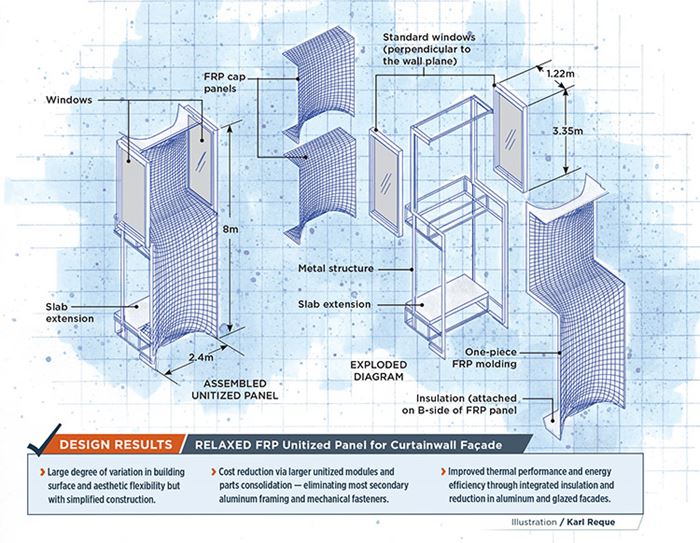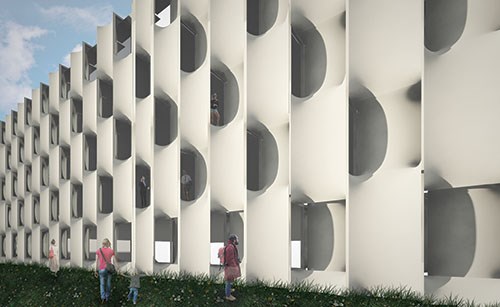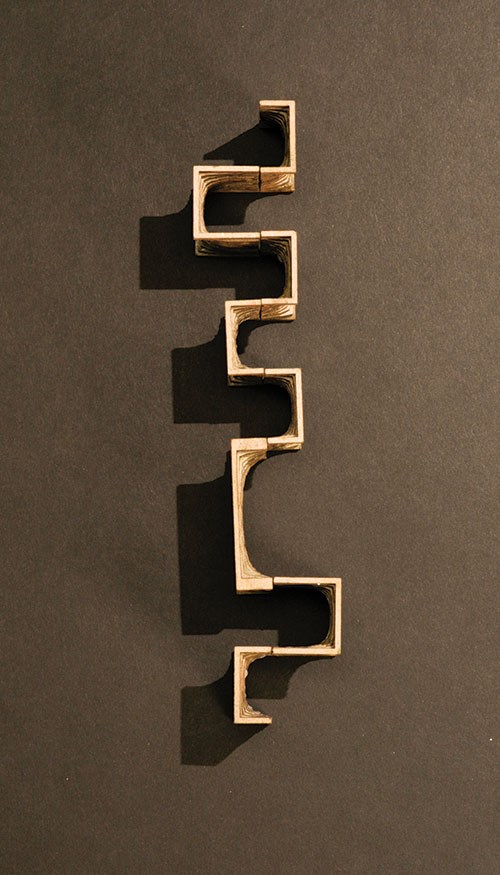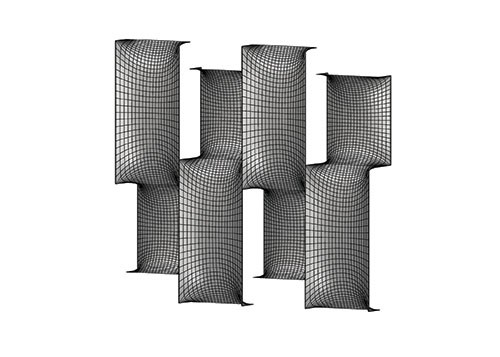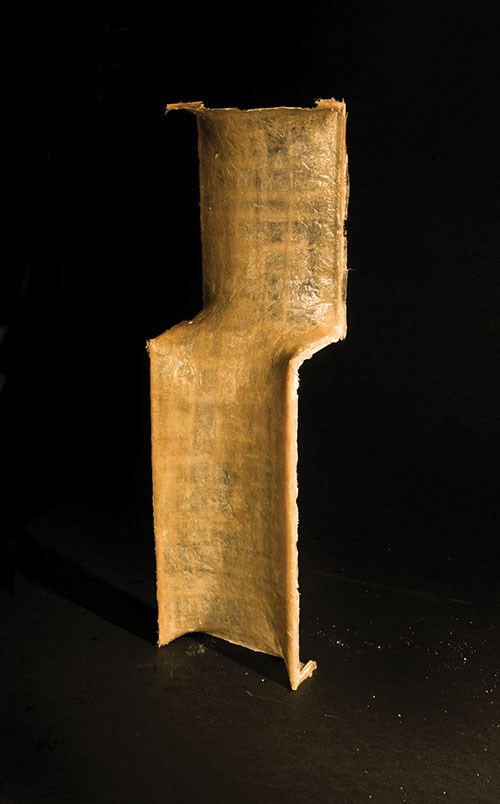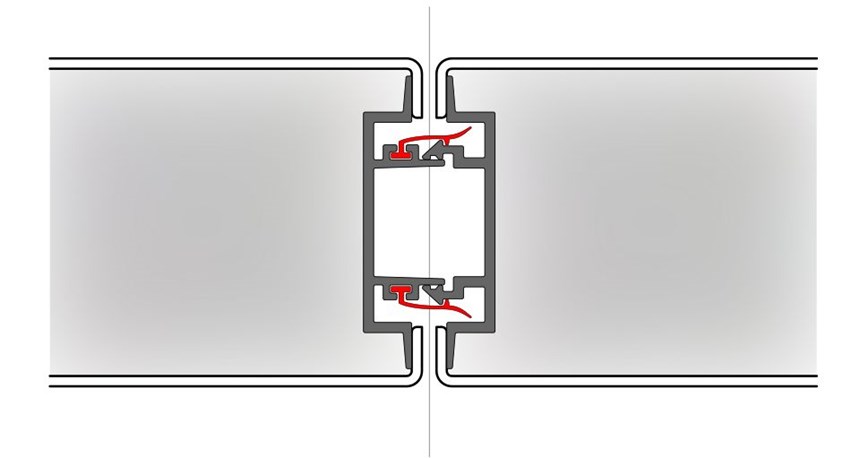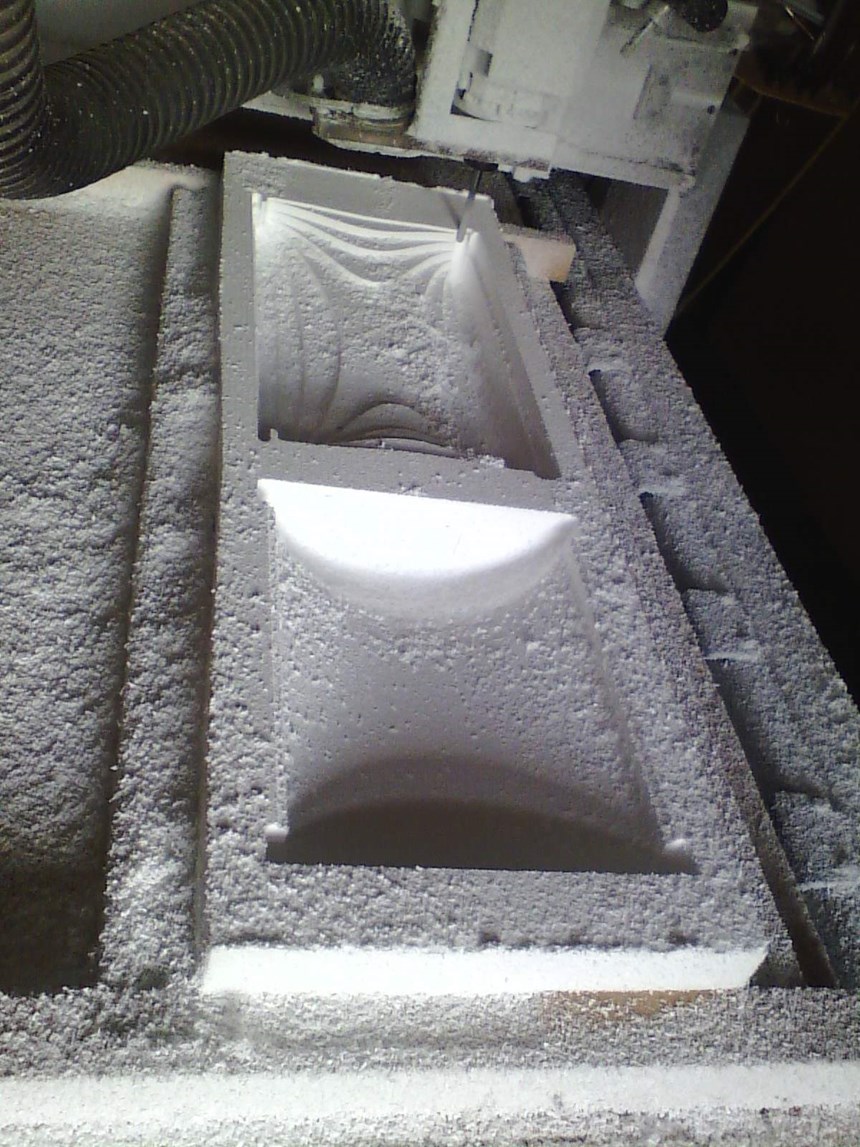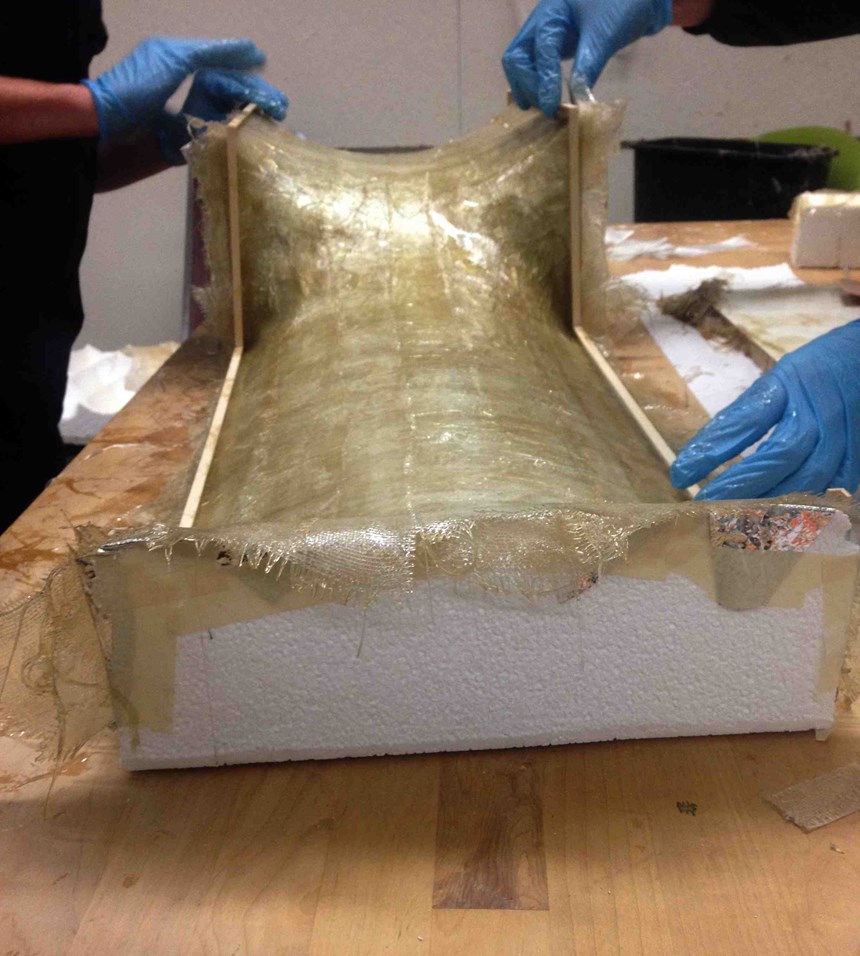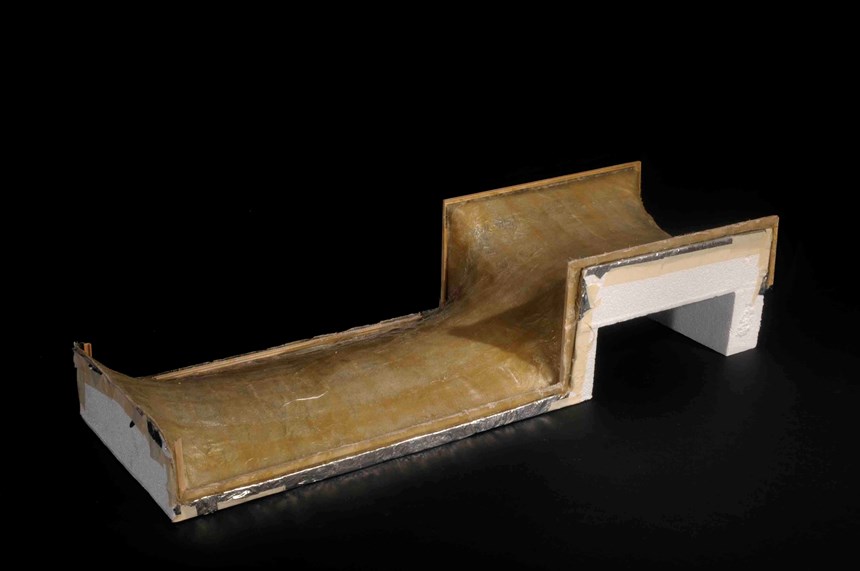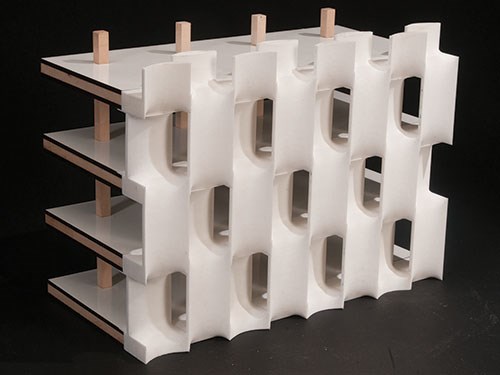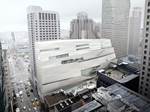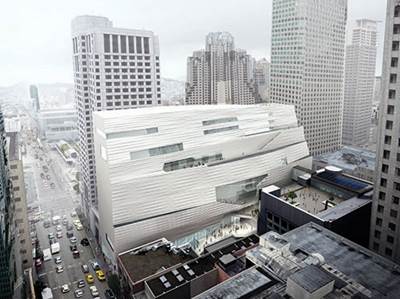The building envelope: FRP unitized façades
New composite design reduces framing, simplifies construction and improves performance vs. conventional aluminum-framed glass curtainwalls.
Design Results:
- Large degree of variation in building surface and aesthetic flexibility but with simplified construction.
- Cost reduction via larger unitized modules and parts consolidation — eliminating most secondary aluminum framing and mechanical fasteners.
- Improved thermal performance and energy efficiency through integrated insulation and reduction in aluminum and glazed facades.
Unitized panel systems have become a popular alternative to conventional, stick-built construction in building envelopes. Prefabricated offsite, under controlled factory conditions, these systems vastly simplify onsite installation, decreasing expensive jobsite labor and shortening construction schedules. In 2009, the International Code Council’s (ICC, Washington, D.C.) International Building Code (IBC) approved the use of fiber-reinforced polymer (FRP) composites in unitized panels. But it was only recently that Kreysler & Associates’ (American Canyon, CA, US) Fireshield 285 panel system, an FRP system that passes the NFPA 285 fire-resistance certification, has allowed economical use on buildings taller than 12m. That system currently forms the largest FRP façade installation in the US, on the San Francisco Museum of Modern Art (SFMOMA) expansion (see "Architectural composites: Rising to new challenges" under “Editor's Picks,” at top right). Fireshield 285 offered SFMOMA the least expensive solution — reportedly 20% less than competing materials — and eliminated more than 450,000 kg of secondary steel structure. But Kreysler’s FRP panels still required the use of a secondary aluminum panel framing system manufactured by renowned façade design/build company Enclos (Eagan, MN, US).
In the wake of the SFMOMA project, Kreysler, Enclos and architects Gensler Los Angeles (Los Angeles, CA, US) tasked design teams in a digital fabrication course at the Material Innovation Lab within California Polytechnic State University – San Luis Obispo’s (Cal Poly SLO, CA, US) Dept. of Architecture with developing unitized panel systems that not only exploit the benefits of FRP to integrate unique molded-shape aesthetics with thermal insulation, but also carry more of the substructural load.
Improved efficiency, reduced layers
“Because composites can handle structural loads, we can get rid of the aluminum structure standard in today’s unitized panel systems,” explains Cal Poly SLO’s Prof. Mark Cabrinha. That’s a plus, especially with windows. Cabrinha explains, “In a house, windows in a wall are placed in what we call punched openings. In an office building, however, a continuous wall of windows hangs in front of the steel structure, and thus, is called a curtainwall.”
Curtainwalls are typically thin and made from aluminum frames called mullions, which support glass, metal and/or thin stone panels. Aluminum-framed curtainwalls are coming under fire, today, because aluminum, although lightweight, is highly conductive. It radiates summer heat into air-conditioned interiors and out of heated interior spaces in cold weather, significantly increasing energy costs. Further, aluminum itself is produced in an energy-intense process, and that affects a building’s overall LEED rating, a voluntary third-party certification that evaluates a building’s construction and operational sustainability (LEED ratings are awarded by the Leadership in Energy and Environmental Design (LEED) certification program. Read more about it here). “Now we start talking about significant improvement in thermal performance and CO2 footprint because aluminum is a very energy-intensive material to produce,” says Cabrinha.
The design teams used a combination of parametric design software, hands-on prototyping and digital fabrication processes to iteratively develop multiple FRP unitized façade concepts (see Fig. 1 & 2, at left). Of these, one named RELAXED offered the most near-term commercial potential. A practical solution that could meet today’s large demand for retrofitting aging buildings where higher performance is required without increasing dead loads, “RELAXED achieves a watertight enclosure and primary exterior surface in the same prefabricated element,” explains Cabrinha. “The design also integrates thermal insulation and drastically cuts solar gain vs. the all-glass façades commonly used today.”
Cabrinha also sees that RELAXED opens an expanse of new design opportunities via “the incredible aesthetic it achieves through complex geometry, and yet it is cost-effective, thanks to prefabrication and simple installation of one basic unit, repeated across the facade.”
“The ultimate goal is to utilize the FRP strength to completely eliminate the secondary structure,” Cabrinha adds. RELAXED, however, is but a first step. “We still used aluminum extrusions to accept the window frames and support the concrete floor slab extensions,” he notes. But the majority of secondary aluminum framing, as well as separate air and water barrier systems, numerous mechanical fasteners and the caulking typically used to combine these layers have been eliminated.
Developing the design
RELAXED evolved from several design objectives. Its name derives from the inward sloping surface of the basic unit and the curved surfaces it creates when repeated across a façade. The visual effect is similar to holding a sheet taut and then letting it sag or relax. “The first prototypes employed a number of different shaped units,” recalls Cabrinha’s collaborator, Prof. Jeff Ponitz, “but this would increase complexity not only in mold and part fabrication but also installation.” Investigations then tacked toward producing the maximum perceived variation in the façade — an aesthetic in high demand — but with minimal labor. “As the design evolved, we realized we could achieve the desired surface variation with a single repeating unit,” says Ponitz (See Fig. 3, at left).
Another objective was to increase interior functional space in the same way a bay window does, exploiting the FRP to mold a shape that projects out from the building face. An intriguing result is that windows are installed perpendicular to the façade’s planar surface, avoiding direct solar gain. “This effectively creates a sun shade,” notes Ponitz, “and also offers some very interesting lighting effects, bouncing indirect sunlight into the building during the day, and radiating light out in the evenings.”
Initially, the maximum size of a RELAXED unit was limited to 3m by 13m to enable truck transport. As the design progressed, the basic unit was finalized as a 2.4m wide by 8m tall, twin-span construction extending from floor to floor for two stories (as depicted in the drawing, top left). This would minimize the need for field connections and enable the use of standard-sized windows, both keys to cost control.
Next came the issue of joint design. Typically, unitized façade systems attach with dead-load anchors to the building’s concrete slabs, and then snap together with blind fasteners to prevent marring of exposed interior and exterior surfaces. Enclos proposed an integrated, shop-applied aluminum snap-lock connection made using male and female aluminum extrusions and flexible snap-lock connectors (see Fig. 4). This achieves a primary and secondary watertight seal, while also providing edge-stiffening and a connection point to the primary structure. A similar design used for the jamb (vertical edges) is also used at the head (top horizontal edge) and the sill (bottom horizontal edge), the latter only slightly modified with a vertical tongue that is received in the head of the lower RELAXED unit.
Fabrication prove-out
With the basic design in hand, students moved on to trial fabrication. “These were fairly crude proof-of-concept prototypes,” explains Cabrinha, “and were scaled down because a full-size mock-up was just too large. Our goal was to test the viability of molding a unit.” Tooling was CNC-machined from expanded polystyrene (EPS) foam (Fig. 5) at Cal Poly Architecture’s Digital Fabrication Lab on a HAAS SR-100 sheet router using RhinoCAM software (MecSoft Corp., Irvine, CA, US). Aluminum foil coated with release wax was used as a mold release, followed by white gel coat modified with fire retardants and hand layed, 4.8-mm-thick chopped glass fiber mat wet out with polyester resin (Fig. 6 & 7). All of the composite materials were obtained from Kreysler & Associates, which sources from a variety of suppliers including Composites One (Arlington Heights, IL, US), CCP Composites (N. Kansas City, MO, US), Owens Corning (Toledo, OH, US) and Ashland Performance Materials (Dublin, OH, US). Wood battens were applied to simulate the aluminum extrusions that will enable joints between adjacent units and attachment to a building structure. Next, the design team 3D printed multiple 1:48-scale RELAXED units, using a Makerbot Replicator2 with white PLA filament. The units were then assembled into a seamless façade mockup (see Fig. 8). “Architects typically don’t make the final product,” notes Cabrinha. “So that was not our goal here, but instead to establish boundaries.” These boundaries are the physical limits for construction. Cabrinha explains that digital fabrication helped to fill in the gap between the theoretically infinitely flexible design and what was actually buildable.
Next steps, next generation
The next steps will include testing of full-scale joints between the aluminum and composite surfaces, full-scale structural testing and a thorough cost-benefit analysis. Cabrinha explains, “We need to complete cost modeling and a lifecycle analysis because, while FRP is more expensive, when we take into consideration the savings in structure, materials and labor, combined with improvements in energy efficiency, we believe this will be a highly competitive product with considerable design opportunity.”
At this next level of investigation, the FRP fabrication process will be finalized. “We know we want to keep the foam inside as a core,” says Cabrinha, “but that means we need a molding process where both sides are finished.” He points out that RELAXED is not limited to any specific exterior finish. “We don’t have to use gel coat, but could opt for the stone-like finish that Kreysler & Associates has produced for SFMOMA or a variety of other options.” Discussions are now underway regarding the funding for these forthcoming investigations.
Cabrinha is optimistic and believes the industry may finally be reaching a tipping point where FRP façades similar to RELAXED will provide cost-effective solutions for the building envelope, balancing design and performance with construction time and cost.
Related Content
Bio-based acrylonitrile for carbon fiber manufacture
The quest for a sustainable source of acrylonitrile for carbon fiber manufacture has made the leap from the lab to the market.
Read MorePlant tour: Middle River Aerostructure Systems, Baltimore, Md., U.S.
The historic Martin Aircraft factory is advancing digitized automation for more sustainable production of composite aerostructures.
Read MoreComposites end markets: Electronics (2024)
Increasingly, prototype and production-ready smart devices featuring thermoplastic composite cases and other components provide lightweight, optimized sustainable alternatives to metal.
Read MoreRecycling end-of-life composite parts: New methods, markets
From infrastructure solutions to consumer products, Polish recycler Anmet and Netherlands-based researchers are developing new methods for repurposing wind turbine blades and other composite parts.
Read MoreRead Next
Architectural composites: Rising to new challenges
In North America, Europe, the Middle East and Down Under, architects and engineers are finding composites are a good fit in groundbreaking applications.
Read MoreAll-recycled, needle-punched nonwoven CFRP slashes carbon footprint of Formula 2 seat
Dallara and Tenowo collaborate to produce a race-ready Formula 2 seat using recycled carbon fiber, reducing CO2 emissions by 97.5% compared to virgin materials.
Read More“Structured air” TPS safeguards composite structures
Powered by an 85% air/15% pure polyimide aerogel, Blueshift’s novel material system protects structures during transient thermal events from -200°C to beyond 2400°C for rockets, battery boxes and more.
Read More

